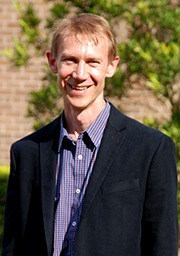Associate Professor Michael Kirkpatrick
The University of Sydney

Biographical Details
Associate Professor Michael Kirkpatrick graduated with a degree in Mechanical Engineering from the University of Sydney in 1996. He then worked with the international building engineering consultancy Ove Arup & Partners in Sydney and their London office. Michael returned to Australia in 1998 to study for a PhD at the University of Sydney. On completion of his PhD in 2002, he was awarded a two year Postdoctoral Fellowship with the Center for Turbulence Research at Stanford University and NASA Ames. In 2004 he accepted a lecturing position in the School of Engineering at the University of Tasmania. In 2006 Michael returned to the University of Sydney where he is currently an Associate Professor in Fluids, Energy and Environment in the School of Aerospace, Mechanical and Mechatronic Engineering.
Research Focus
Associate Professor Michael Kirkpatrick's research focuses on developing new and more accurate mathematical river-simulation models to predict the effects of weather, climate and flow-rate changes on water quality, enabling better management of Australia's rivers and estuaries.
"My current research focuses on the effects of thermal stratification in rivers. This occurs mostly as a result of heating by the sun, which causes the water near the surface of the river to become warmer than the water deeper down. The warm surface water is lighter than the cooler water below, so it floats on top like a hot-air balloon floats in the sky. This prevents the mixing of water that is essential for the river to remain healthy."
"A lack of mixing prevents oxygen from being carried to the deep waters, and prevents contaminants in the deep waters from escaping, making it acidic and toxic. If this situation lasts for more than a couple of days we end up with serious environmental problems, such as algal blooms, mass fish deaths and damage to the river's ecosystems."
"There are a number of natural physical processes that break down this stratification and allow a river to mix properly, and the basic idea behind my research is to develop models that can predict how effectively these processes will be operating over the coming week or so, given the current weather and flow conditions. If the model predicts a level of mixing that may lead to environmental problems, then river management authorities can increase the flow rate by releasing water into the river from upstream storage reservoirs, to prevent this from occurring."
"My aim is to develop a new generation of river-management tools that will enable us to optimise water allocation, balance the needs of all water users, and maximise both economic and environmental benefits."
River Management Models
Developing new, more accurate mathematical river simulation models to predict the impact of weather, climate, and flow rate changes on water quality for better management of Australia's rivers and estuaries.
Thermal Stratification
Investigating thermal stratification effects in rivers caused by solar heating, which can lead to environmental problems such as algal blooms and ecosystem disruption.
Computational Fluid Dynamics
Utilizing advanced CFD techniques and the PUFFIN simulation code to model complex fluid dynamics in environmental and engineering applications.
Research Simulation Videos
Below are some videos from simulations completed for this project. Details are in the description on Youtube. These simulations were completed with my computational fluid dynamics code PUFFIN.
Day-time river flow with solar radiative heating
Night-time river flow with surface cooling
Day-time flow through a sharp river meander with solar radiative heating
Teaching and Supervision
Fluid Mechanics
Associations
Professional Memberships
Research Themes
Water and the environment